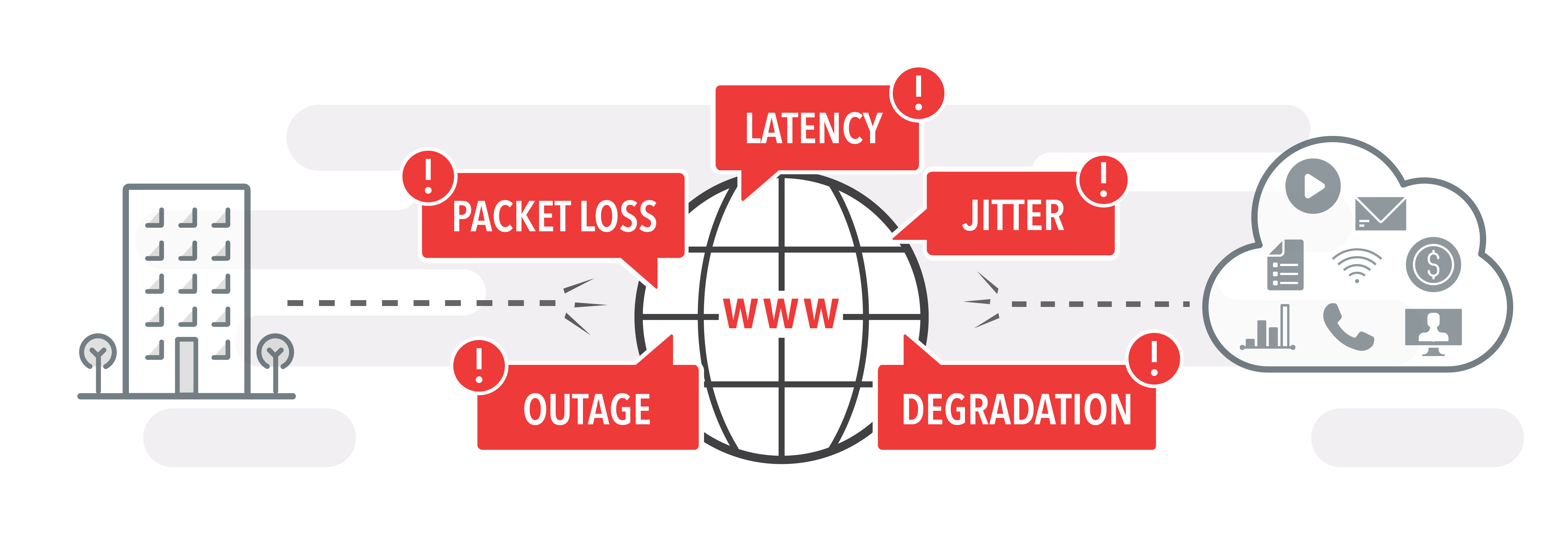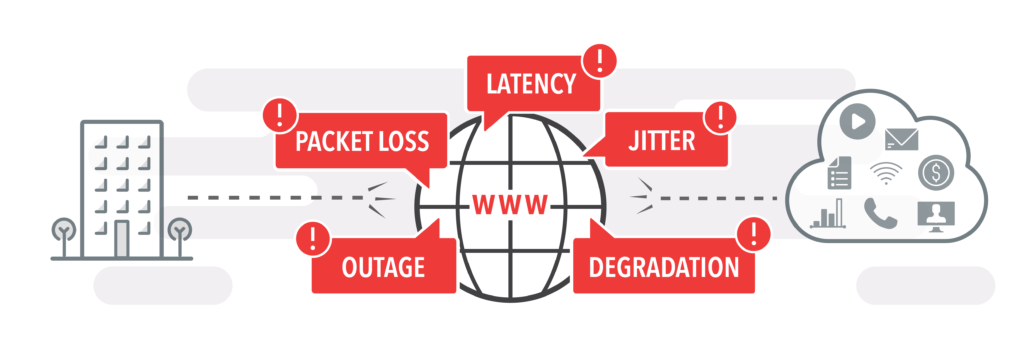If you’re responsible for IT at a small or mid-sized business (SMB) you know this pain all too well. It starts with a support ticket that the phones aren’t working right. But when you go to check them, they’re working fine.
You call the ISP and wait on hold for hours only to have them say, “There are no issues on our end.”
You call the VoIP provider and they tell you to call the ISP.
You’re left waiting until the next complaint with no idea how to fix the issue. It’s a never-ending game of whack-a-mole that leaves end users frustrated. New technologies start to look like bad choices, and IT pros are left with an embarrassing problem they can’t fix.

Cloud and SaaS technologies are enabling a wave of growth and innovation for SMBs and mid-sized enterprises. Whether it’s UCaaS, Office 365, a point of sale (PoS) service, or an industry-standard SaaS app, cloud technologies can transform a business, making it more innovative and competitive. These technologies have something else in common: they all need a reliable connection from an Internet Service Provider (ISP) to work properly.
Unfortunately, as most have experienced, almost all ISPs have trouble providing a reliable and performant connection. The complex nature of the internet causes every ISP to have occasional outages and performance issues. In turn, those issues wreak havoc on end-user experience in the form of dropped VoIP calls, choppy video conferencing and unresponsive apps. These issues erode user confidence, reduce productivity, and prevent organizations from implementing and adopting the new cloud-based technologies they need to compete.
So how do you end the cycle? Well, let’s start by taking a look at some of the root causes at play, some of the traditional approaches that have failed and how a new technology like Bigleaf could fix it all.
Outages are only the beginning of your problems
A quick visit to Downdetector demonstrates that there are always ISP outages somewhere. Sometimes outages last days, more often they’re over in seconds. Either way, outages are a major disruption. But as annoying and visible as they are, outages aren’t the real culprit of most ISP-related business disruptions.

Most user complaints are caused by ISP performance issues that are far more common than outages. Latency and packet loss show up in choppy VoIP calls. Jitter can make calls sound robotic. These kinds of performance issues happen when the network is overloaded or a partial outage causes packets to re-route over sub-optimal paths. Problems like these create costly, time-consuming disruptions in a business precisely because the underlying issues are almost impossible to detect and resolve.
Let’s put these outages and performance issues into perspective. According to Bigleaf’s own monitoring data, the average ISP circuit suffers 3.5 hours of downtime in a month. That’s pretty shocking. But what’s more surprising, and frankly more concerning, is the 23 hours of “unusable” performance in a month.
“Unusable performance” happens when packet loss, latency and jitter are so bad that you can’t make a VoIP call, run a video conference, or use a real-time application effectively. So that’s almost a full day — or three full business days — of total disruption per month.
So, with those two challenges in mind, we’re now talking about more than 24 hours each month where sales can’t make calls, customers can’t reach support and productivity grinds to a halt.
A lot of us tend to assume these ISP issues only happen in places like Drain, Iowa or the middle of the Mojave Desert because of lack of choice. The reality is that business and tech hubs like Denver, Portland, Seattle, Los Angeles, and much of the Bay Area are also danger zones for many prominent service providers because of oversubscription and aging infrastructure.
But it’s been this way for decades. What’s the big deal?
Unreliable internet isn’t just an IT annoyance, it’s a companywide problem
Many SMB and mid-size enterprises tend to overlook these bandwidth and performance issues until it’s too late. You can overlook a faulty ISP if Dan from accounting experiences buffering while watching a cat video at lunch. But there will be organization-wide heartburn if the CEO’s conference call fails while he’s presenting to the London branch about their new GDPR mandates.
Quite often, a high-profile failure like this leads to frustration across the organization, and the onus of that failure typically falls squarely on the IT department or MSP. As you might remember from the intro, that process rarely turns out the way we might hope. These technology failures continue, eroding trust in that tech personnel and casting doubt on the new technologies themselves.
We’ve found that application reliability drives end-user adoption of new technologies. When you roll out mission-critical software that doesn’t function right, that impacts every corner of your organization in the form of downtime, lost revenue, and erosion of trust from customers.
Why wait for an embarrassing disaster to learn that your ISP is hindering new technology adoption or frustrating your colleagues and customers?
It’s time for a cloud-first approach to internet connectivity
Whether your business is already knee-deep in Cloud applications or just starting out with VoIP phones, you need a reliable network for them to ride on, one that is 100% dependable for both today’s usage and tomorrow’s demands. The real goal here is to build an architecture that transforms commodity broadband into enterprise-grade service and does not send you diving for the antacid all the time. We call this a Cloud-first approach to internet connectivity
It starts with redundancy. Since every ISP has outages and performance issues, it’s essential to have multiple ISPs connecting you to your critical Cloud applications. Instead of betting on one big fiber circuit, diversify across a smaller fiber and cable provider. It’s great to have a 4G circuit for diversity in the worst-case scenario.
Redundancy can’t prevent disruption in real-time if it’s not managed in real-time. Your dual-WAN firewall can failover in the case of a hard outage, but any calls or session-based traffic will drop. Even then, you’re only using one connection at a time, and not to the best effect. Luckily there are new intelligent technologies like Bigleaf SD-WAN that auto-detects your application needs and adapt to changing ISP conditions in real-time. It monitors circuits constantly, prioritizes your most important apps and ensures that ISP performance never impacts the end-user experience.
No technology stack remains static for long. When more new apps are deployed and traffic patterns change, your network should adapt without having to change policies or configurations. With Bigleaf SD-WAN, performance-sensitive traffic is instantly classified and prioritized over functions such as bulk file download. This isn’t based on static app-specific rules, but instead intelligent auto-adaptive heuristics and algorithms. In other words, no matter what technologies you adopt your network will always keep up…and the CFO’s London conference call is never derailed by Dan’s cat video.
With the right solution, it’s possible for SMB and mid-sized enterprises to realize the same performance, redundancy, and reliability enjoyed by enterprise-level corporations. With a cloud-first network purpose-built for your needs, you don’t suffer from daily internet woes.
With the right solution, everyone in your business receives the same cloud-ready Internet. VoIP and UCaaS perform flawlessly regardless of outages, packet-loss, jitter, or lag. Critical apps never fail because their traffic is always prioritized. Your users never feel the impact of ISP issues and your cloud technologies always perform the way they should.
Because we do ask a lot from our ISPs, it is critical that we strengthen them with technologies capable of delivering enterprise-grade, worry-free service — improved performance for every app, anywhere in the world.
You can finally solve the “crappy internet” problem.
